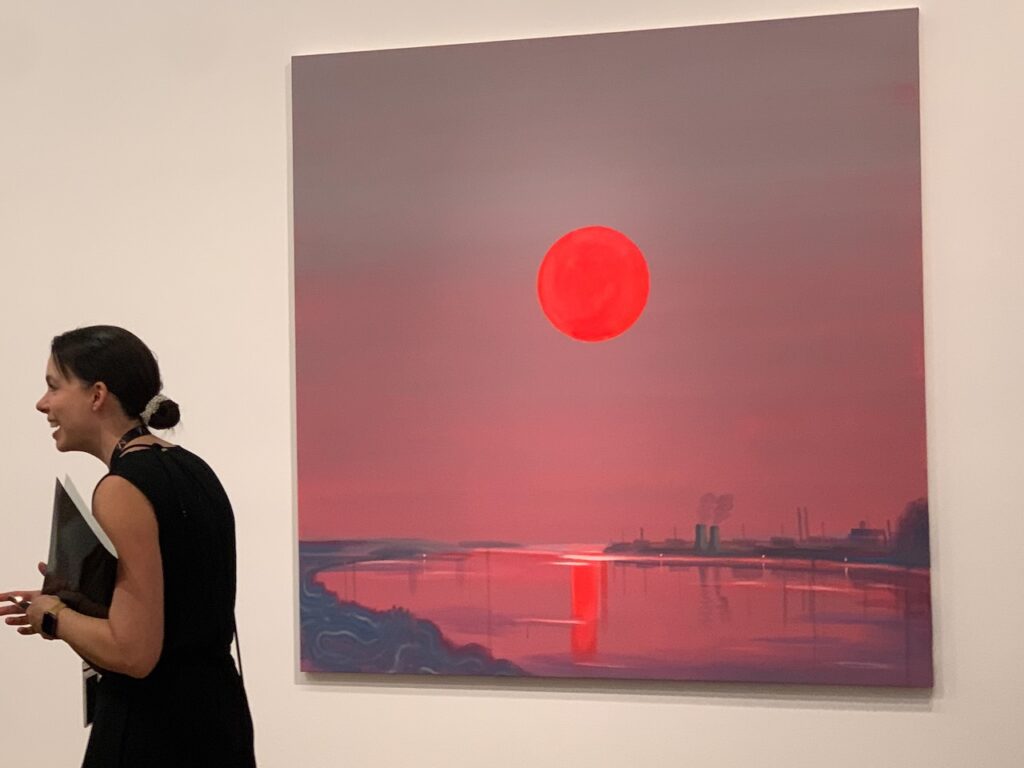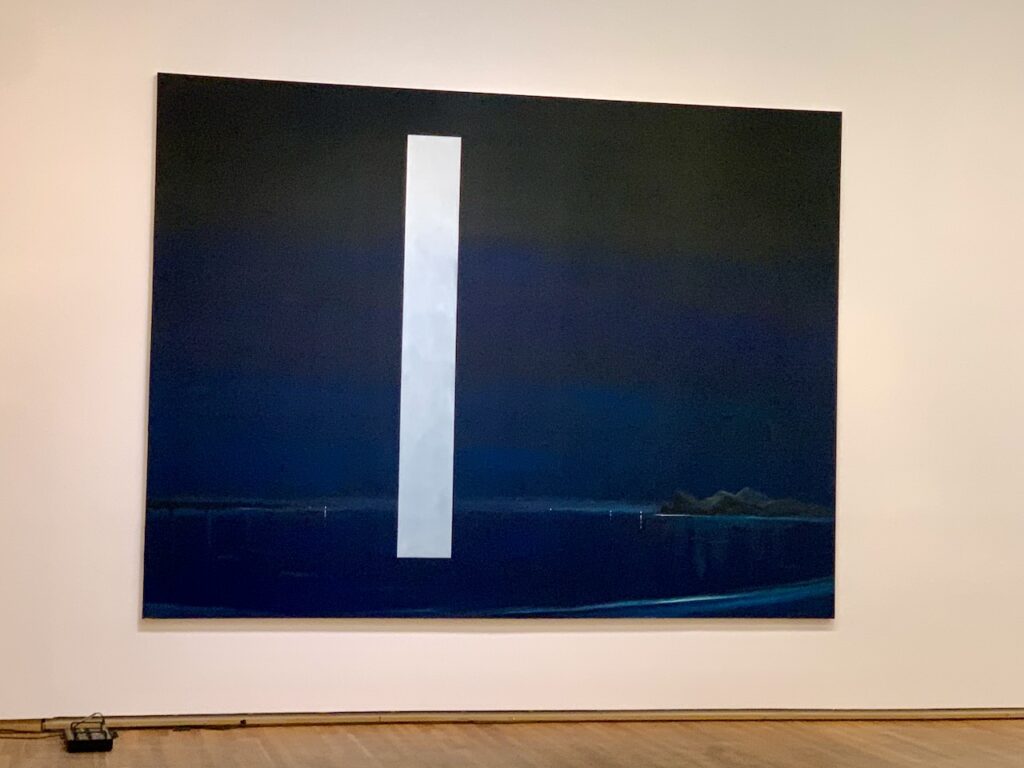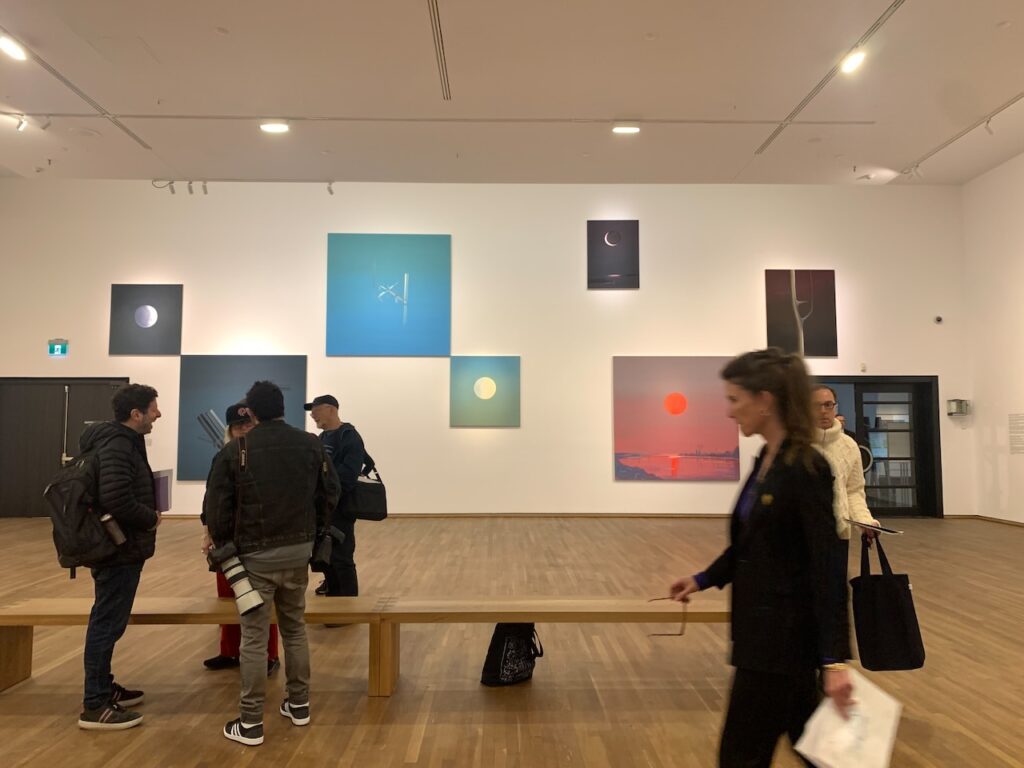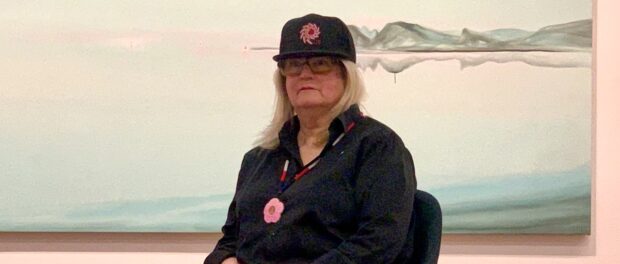Thinking big : WHO OWNS THE MOON exhibition
Just a day after the eclipse, who better to feature in a newly opened exhibition than Canadian contemporary artist of celestial awe, Wanda Koop. The exhibition WHO OWNS THE MOON at the Montreal Museum of Fine Arts allows some much-deserved contemplation for the massive acrylics of this Winnipeg painter. Contained in a single room at the museum, the works featured include studies of the moon and other “objects of interest,” blow-ups of everyday items, and a series of atmospheric landscapes of the Black Sea that contrast with vertically positioned rectangular blocks of colour, signatures of the artist.

Like many contemporary works, to derive the greatest value a visitor must take time to sit with the work and contemplate both the process and meaning of each piece. Benches provide an opportunity to look from a distance, though a close-up inspection reveals many small details in the layers of paint that may not be obvious. The light of tiny ships shows movement to the distance, a foreground shape contains bands in shades of dark purple, tiny white spots pop up in the still blue water, a braid suggests greying hairs amongst dark ones.
In an interview for the press, Koop discussed her process for creating the massive works. At her studio, she uses an easel the size of the paintings. “It’s the size of a garage door,” she says. But she also lays the paintings flat on the ground and walks on them. She begins each work with a long period of study, sometimes lasting years, in which she does trial paintings and takes hundreds of notes. Then, layer by layer, she builds the painting. “I want to achieve paintings that are full of light,” she says.
Each day, before picking up her brush, she has a meditative start to her work. “I lie very still and envision how I will approach painting in my head,” she says. This allows her very large works to become smaller in her head and more manageable. “I think about how the layers will interact with each other.” To a certain degree, she is translating what is in her head into the works “My first language is the visual,” she says to the audience. “Then English.”
“I’m shocked when I’m done,” she says and agrees with a questioner that the works imbue emotion that can be read visually. “The works are larger than myself.”

When the works are hung, she is detached as their creator. She becomes no different from “a viewer who comes through the door.”
The works mesh well together, which underscores something else she says about her work, “I consider myself an installation artist.” In looking at the totality of the room for WHO OWNS THE MOON, each piece speaks to the ones closest to it as well as the ones on opposite walls. One imagines the curator and the artist working together carefully to fill the room in a way that allows each painting to be appreciated singly but also as part of a unit, and then as part of a totality.
There are three series of Koop’s paintings that stood out to me in particular. The first is the series “Objects of Interest,” which focuses on things in the sky such as the moon and the International Space Station. The moon, Koop says, belongs to no one and everyone at the same time. In looking at her “portraits” of the full moon, reflecting and emanating light, in the sky as well as over the Ukranian power plant, the viewer’s head can fill with this very thought. What does it mean to be a part of nature as a human, notably that part of nature that claims spaces and territories. The human desire to understand and to build is both tinged with noble and selfish ends. Is a nuclear power plant (poignantly, the one that was bombed by Russia in the recent war against Ukraine) on balance a good of harmonizing with all things or a continued violation of the environment? Also, when building such things, what do we as humans put at risk, and what are humans willing to risk by attacking something that can destroy the innocent, the vulnerable, and things seemingly disconnected from human life? Similarly, what is the purpose of the International Space Station? While one might expect the picture to appear more in a Scientific American as a photograph celebrating human achievement, setting it in a painting opens up a question of why humans do what they do, what they claim dominance over, and what are the responsibilities attached to that. During the interview, Koop acknowledges the horrific side of human nature and feels despair, but she also says she believes in human people. “The world is incredible,” she says. “Not a day goes by that I don’t think that. We look at the moon and we are in space too and we are on the most beautiful planet.”
I was also struck by a series of paintings of small, domestic things made enormous in the series “Sleepwalking.” The four vertical paintings of this series at first seem simple and uncomplicated next to the others in the room. But one in particular held my attention, “Cross stitch.” The title led me to focus on the choice of subject. The painting features simple white crosses against a white background. The crosses are highlighted and lowlighted with other shades and colours, arranged in a pattern one might find along the edge of a cloth napkin. Having just looked at the images of the moon and the massive human constructions, I considered how the ordinary can also invoke awe. Cross stitch is traditionally women’s work, decorative, conservative, the work of past generations and hobbyists and so almost irrelevant today. Yet it is simultaneously beautiful, time-consuming, and requiring skill. It makes me think about how so many human efforts are missed because they have become ordinary or are simply devalued for being associated with women. By painting a simple cross stitch pattern and setting it beside these other works, the concept of cross stitch was no less significant than a massive project like a power plant or a space station. Further, I considered how it evoked the red and white patterns of Ukrainian embroidery, which was again an interesting juxtaposition with the series on the Black Sea and the power plant.

Finally, Koop’s atmospheric landscapes, the Black Sea Portal series, are the most striking of the collection. These four wall-covering paintings are bold in their colour schemes and make use of subtle colour changes to stand with such grandeur. Here the space is filled with gradiated colour transitions that move vertically. In the bottom quarter of each painting lives the human scale, the sea, the mountains, the ships. The upper portion is an endless sky. Set off against these quasi-monochromatic landscapes is a contrasting vertical stripe of colour that breaks the landscape which jolts the viewer into making sense of its presence. The stripes themselves, as it turns out, also subtly change colour and further, look different from close up and far away. In one, the bar seems like an open window to another world, in another, it is a neon sign. And, of course, one is reminded of the ongoing war in Ukraine.
All in all, WHO OWNS THE MOON is a satisfying exhibition. Taking time with the space allows for dialogue to happen between the works and also with Canadian ideas about landscape and the global concept of belonging. There are no simple answers here, but rather, an invitation to sit and think, just as if joining the artist each morning before she begins her work to consider what is it all for, what it all means, and where are we going.
WHO OWNS THE MOON is at the Montreal Museum of Fine Arts (1380 Sherbrooke Ave) until August 4. Information HERE.






